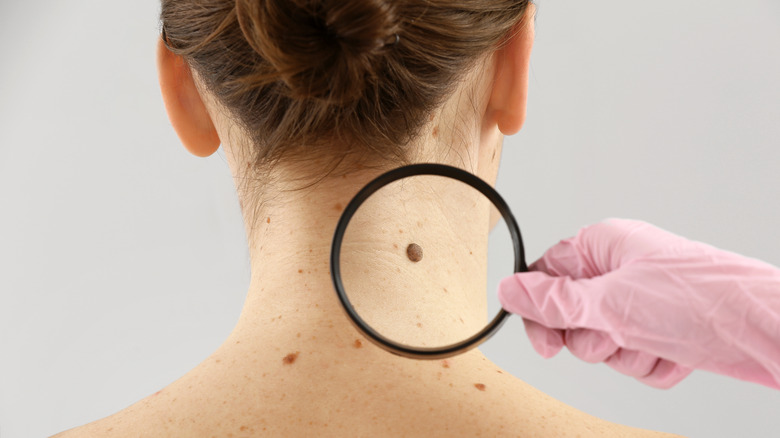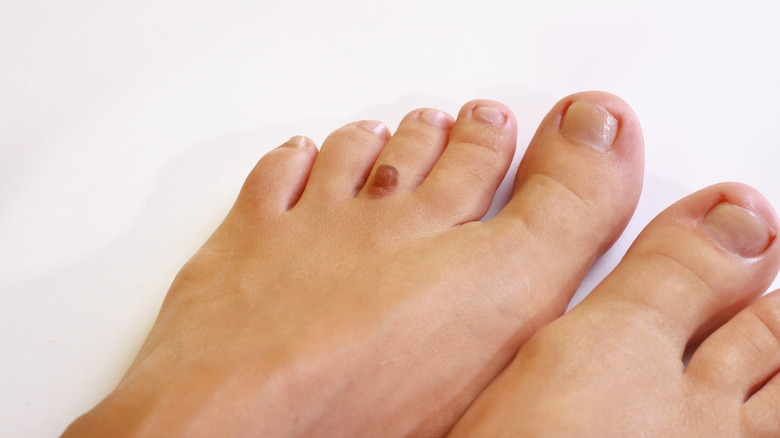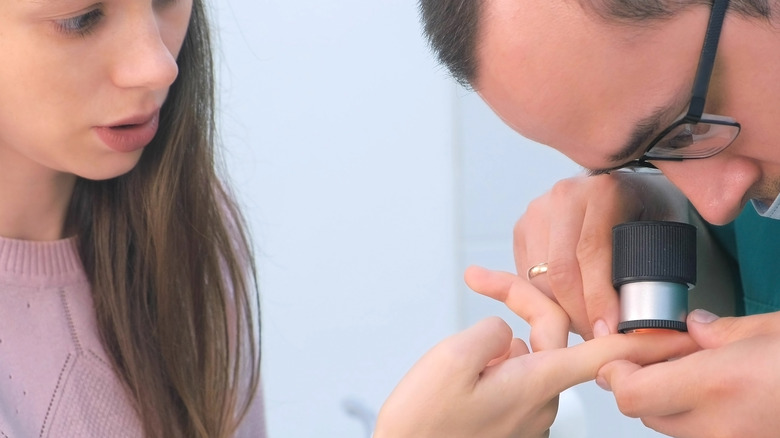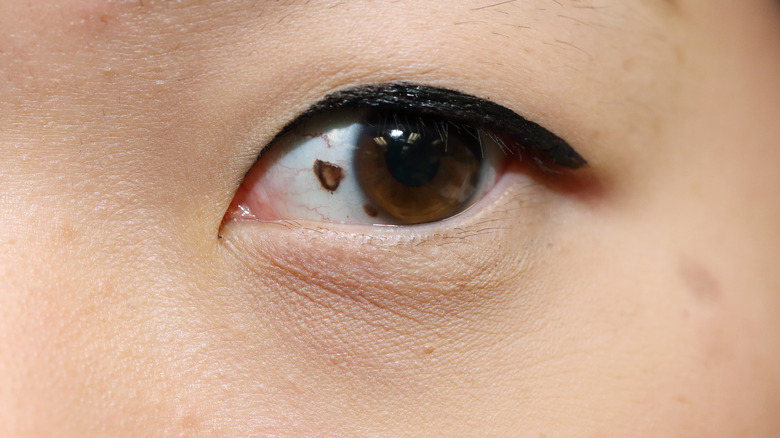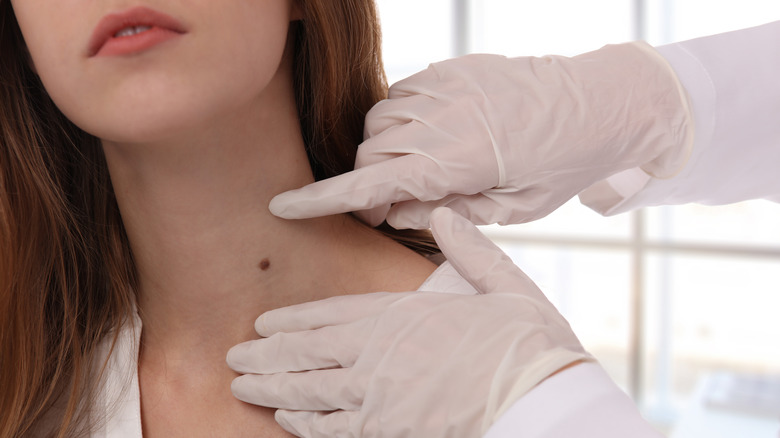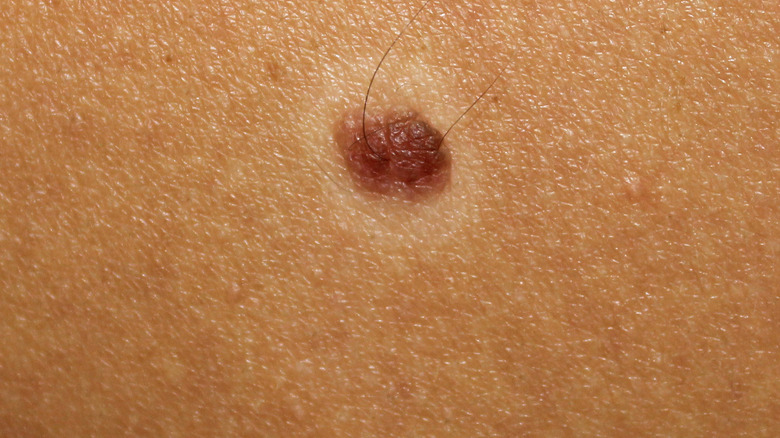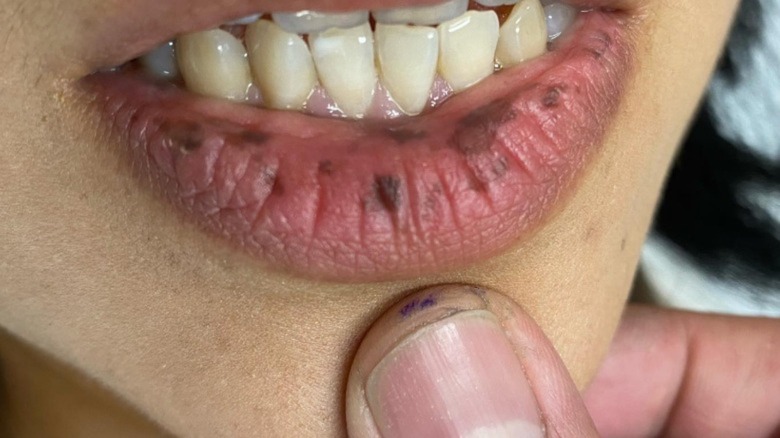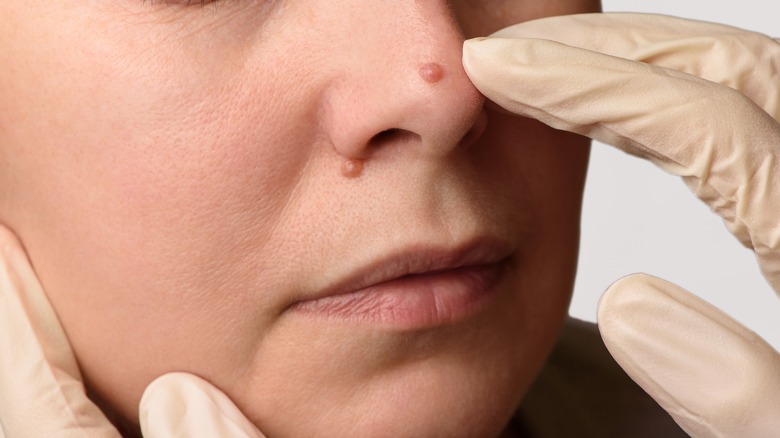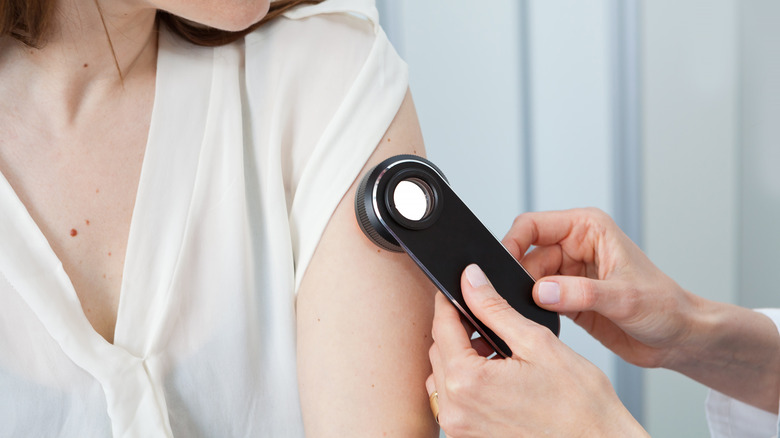Moles On Each Location Of Your Body Explained
A mole (scientific name: nevus) is a growth on skin comprised of a cluster of skin pigment cells (aka melanocytes), according to Medline Plus. Moles can be flat or raised, but not all raised skin growths are moles. Some may be skin tags or seborrheic keratoses, for example, although it can be difficult for someone who is not trained in dermatology to know the difference (via WebMD).
The average adult has between 10 and 40 moles on their body in various locations. These can come in various colors — including red and blue, but most are brown, beige, or pink (via Healthline). Moles come in many sizes and shapes, with most being round or oval and having a diameter no larger than a pencil eraser (5 millimeters). Although some moles are present from birth, others develop over time. Some moles, however, fade with age. Moles are often found on parts of the body that receive sun exposure (via Medicine.net). Nevertheless, some moles are found on parts of the body that receive no sun exposure at all, like the genitals (via Mole Map).
In folklore, mole location has been seen as relevant to one's personality or fate. In modern medicine, the location of any mole on your body may be considered a factor in assessing your prognosis if a mole were to be, or become, cancerous (via WebMD). Let's take a look at what moles on each location of your body might really mean to your life and your health.
What it means when you have a mole on your foot
Since you probably spend a lot of time wearing shoes, you might not be all that aware of having a mole on your foot. But it is a good idea to examine your feet periodically for moles and other skin growths, according to Medical News Today.
In the case of a cancerous mole, your prognosis will be better the earlier you catch it. Specifically, melanoma, a type of skin cancer that develops in the skin's pigment cells (melanocytes), can spread to other parts of the body via the lymph system, making the cancer more challenging for doctors to treat (via American Cancer Society).
Although melanoma accounts for only about 1% of all skin cancers, it does cause the highest number of deaths of all skin cancers combined, and 3 to 15% of all melanomas originate on the foot or ankle, according to a 2010 paper published in the Journal of Foot and Ankle Research. Although foot melanoma typically appears on the sole of the foot, it can also appear under a toenail, explained Medical News Today. A melanoma occurring under a toenail or fingernail is known as a subungual melanoma and may appear in its early stages as an unexplained dark streak or spot (via U.S. Dermatology Partners).
Moles on the scalp: How do they get there and what do they mean?
According to ancient Chinese astrology, having a mole anywhere on your scalp is considered auspicious, symbolizing "lifelong good luck envied by others" (via Your Chinese Astrology). But according to Western medicine, a mole on the scalp may be worrisome for the simple reason that, depending on where on the scalp it is located, it may be difficult for you to see and monitor any changes without the assistance of a friend, family member, or medical professional (via Healthline). Monitoring moles for changes is important because a change could be an early sign of melanoma (via Skin Cancer Foundation).
Because moles are most often found on areas of the skin that tend to be exposed to the sun's rays, they are thankfully not usually found on the scalp, according to the National Cancer Institute. But it is possible to be born with a mole on the scalp, according to Cincinnati Children's Hospital, and for parts of the scalp to be exposed to the sun. All moles should be monitored for changes every one to three months, according to dermatologist Jodi Ganz, who also pointed out to Piedmont that everyone should have at least a baseline dermatological exam to "map out" their existing moles and determine their level of skin cancer risk.
A mole on your penis may not actually be a mole at all
A mole found on the penis is unlikely to be dangerous and may, in fact, not even be a mole, according to Columbia University's Go Ask Alice. If a skin growth on the penis is rounded and white or pink, for example, it is less likely to be a mole and more likely to be a "pearly penile papule," which is generally harmless, although only a medical professional can diagnose a growth for certain.
Other skin growths that may appear on the penis include skin tags and sebaceous cysts, among others. Most are considered harmless, although occasionally what appears to be a mole on the penis may be the result of a sexually transmitted disease such as HPV (via Healthline). Like moles found on other locations of the body, a mole on the penis may be present from birth or may appear later. In either case, any change, including a change in size or color, or the presence of bleeding, warrants a consult with a medical professional.
A mole located on the vagina may indicate this
Skin growths on the vagina are more likely not to be moles, but rather skin tags, according to Healthline, presumably because it would be unusual to receive sun exposure on the vagina, even if one were to routinely sunbathe in the nude. Skin tags are always benign, but it is possible to mistake a mole for a skin tag, and a mole that resembles a skin tag can, like any mole located anywhere on the body, become cancerous.
One may be born with a mole on or adjacent to the vulva. Alternately, a mole in this location of the body may develop spontaneously (via American Cancer Society). If a vulvar mole is or becomes cancerous, it will usually appear as black or dark brown, but other colors are also possible, including white, pink, and red. Most vulvar melanomas are found around the clitoris or the labia majora or minora.
Additionally, some vaginal growths that appear to be skin tags or moles can actually be genital warts, according to Healthline. Therefore, it's best to let a medical professional decide what any particular vulvar growth might be.
What it may mean if you have a mole anywhere on your hand
The hands — whether the palm, fingers, or underneath the fingernails — are another location on the body where you might notice a mole, according to Beaumont. Just like a mole located anywhere else on the body, a mole on the hand can be completely benign or a symptom of skin cancer. The most commonly diagnosed skin cancer of the hand is squamous cell carcinoma, which, like a mole, can appear as a brown or tan skin lesion, but is likely to crust over, like a cut that hasn't yet healed, according to the American Society for Surgery of the Hand.
The most serious concern when one has a mole on one's hand is whether it could be, or develop into, melanoma. However, a 2011 study published in Oncology Letters suggested that melanomas of the hand most often present on the thumb, and less often on each consecutive finger after that, including under the fingernails of each digit. Melanomas of the fingernails, which comprise about 1.4% of all melanoma diagnoses, can look more like bruising than a mole. But as with moles and skin changes located anywhere on the body, it's best to leave it to a medical professional to decide what any given skin lesion might be.
Here's the deal with moles located near the mouth
Moles that are located on the face, especially those on the cheek, near the lips, are often referred to as "beauty marks," thanks, in part, to Marilyn Monroe, Cindy Crawford, and Madonna popularizing the lip-adjacent mole. That said, some of the thanks may be owed to a preponderance of folklore that associates having a mole located on or near the lips as an auspicious attribute (via Your Chinese Astrology). In addition, the 1843 short story, "The Birthmark" by Nathaniel Hawthorne (in which a beautiful woman's demise was brought on by her husband's insistence on having said birthmark removed), may have contributed to the magical aura that appears to surround moles located here.
From a scientific perspective, however, a facial mole is simply a mole on the face that was either present from birth or developed over time as a result of genetic predisposition, sun exposure, or some combination of the two, and the fact of the matter is that the more moles one has, the more likely one is to develop melanoma (via American Cancer Society). Nevertheless, facial moles, including those located on the lip itself, are no more likely to develop into melanoma than moles located elsewhere. A 2018 paper published in the World Journal of Clinical Cases suggested that, like all skin growths, those on the lips should be routinely monitored.
If you have a mole on your ear, here is what you should know
Moles can appear on the ear lobe, ear rim, and the skin outside the ear canal (via Verywell Health). What does it mean if you happen to have a mole on your ear? Well, like a mole anywhere else on the body, it can signify absolutely nothing more than a genetic predisposition to developing pigmented skin growths. But it might also signify something more sinister such as skin cancer, or specifically, melanoma. In fact, a mole located on the ear that is or becomes melanoma carries with it some unique risk, according to a 2013 study published in the American Journal of Surgery.
"The external ear represents a site with high ultraviolet exposure and thin skin overlying cartilage," the study authors wrote, suggesting that the skin of the ear is at particular risk for the development of ultraviolet-induced cellular changes. Additionally, ear melanomas may have a slightly higher rate of recurrence due to imprecision at the time of diagnosis, surgical excision, and initial cancer staging.
A mole in the eye? This is what that's all about
A "mole" in or on the eye is often referred to as an "eye freckle" or, if you're in the science world, an eye "nevus," according to the American Academy of Ophthalmology (AAO). Eye nevi are actually quite a bit more common than you might realize. Like moles located elsewhere on your body, they are made up of skin pigment cells. They can be present at birth, or they can develop over the course of one's life. Also, like moles located elsewhere on your body, a nevus in the eye should be watched for changes because it can become cancerous over time. However, a non-congenital eye mole is at a higher risk of becoming cancerous, according to the AAO, presumably because it reflects damage done by the sun's ultraviolet rays.
Nevi can appear anywhere on the eye, including the white, the colored iris, and the retina (inside the eye, at the back). A retinal mole is known as a "choroidal nevus." Your ophthalmologist is trained to identify choroidal nevi and can determine whether one in your eye is raised, orange in color, or leaking fluid, all of which could be a sign of choroidal melanoma. When an eye mole turns out to be cancerous, doctors will often recommend aggressive treatment because of the proximity to many lymph nodes, which offer access to distant organs (via Johns Hopkins Medicine).
Should you be concerned about a mole on your neck?
A benign mole anywhere on the body is still a benign mole. The issue is if it begins to develop into melanoma, which is possible for any pigmented growth of the skin because such growths arise from melanocytes, which give the skin its pigment. And melanoma begins as an abnormal growth of melanocytes (via Johns Hopkins Medicine). That being said, 75% of all melanomas are found before they've had a chance to spread through the lymph and vascular systems. Melanomas that have not yet spread are, of course, easier to treat. And a mole that is visible on the neck is easier to self-monitor than one in a less visually accessible location on the body.
Still, a melanoma found on the neck (or anywhere on the head or neck) is statistically more likely to spread to distant organs than melanomas originating elsewhere on the skin, according to the American Academy of Dermatology. However, melanomas of the head and neck are "uniquely influenced" by the location of the primary lesion, which is usually (but, unfortunately, not always) the mole that you can see on the skin, according to one older study published in Cancer. If a mole on the neck is diagnosed as melanoma, the prognosis is somewhat more favorable than moles on the ear and scalp that end up being diagnosed as melanoma.
Moles on the leg differ depending on where on the limb they are located
"The anatomic location of a primary malignant melanoma has prognostic significance," according to a 2000 study published by the American Cancer Society, with "primary lesions of the lower extremity" being "generally associated with a more favorable prognosis" than primary lesions of the head, neck, or torso. That means that if you have a mole (or moles) on your leg (or legs), and you begin to observe changes in the shape, color, size, et cetera, getting prompt medical attention may mean the difference between a minor surgery to remove and biopsy the mole and extensive systemic treatment for melanoma. In addition, it turns out that where a mole is located on the leg may also impact your prognosis.
As the ACS pointed out that "several retrospective studies have suggested that melanoma on the foot portends poor survival" as compared with melanoma originating somewhere higher on the leg, including the thigh. Although that might seem counterintuitive when you consider that the foot is much further away from the torso, where most of your vital organs are located, this might be explained by the fact that melanoma that originates under the toenail is associated with a worse prognosis than other forms of melanoma.
What it means when mole reappears after removal
Some people have moles removed for cosmetic reasons, as opposed to health reasons. In either case, a mole that has been removed could turn up again in precisely the same spot, according to the medical professionals at Perri Dermatology. At the time a mole is removed from the skin for any reason, it will be sent for a biopsy, as a matter of course (via MD Anderson Cancer Center).
If the pathologist performing the biopsy observes any abnormal cellular characteristics or behavior — even if the mole was removed solely for cosmetic purposes — more skin will be removed in order to obtain what doctors refer to as clean margins (via NYU Langone Medical Center). Once a mole has been excised with clean margins, it is highly unlikely to grow back because all of the pigment cells that gave rise to the mole will have been removed entirely. However, it is nevertheless possible for regrowth.
The fact that a mole — even one that turned out to be suspicious or malignant — returns does not mean it is cancerous, according to Perri Dermatology. But it could. Therefore, if a mole reappears where it was previously removed, it is best to have it looked at by the doctor who performed the excision.
The case of the disappearing mole
Dermatologists typically offer a mnemonic device to remember what to look for as danger signs when you examine your moles: ABCDE (via Skin Cancer Foundation). A is for asymmetry (an asymmetrical mole is more likely to be abnormal). B is for border (uneven or blurred borders can be a sign of melanoma). C is for color (multiple colors and changes in color can signify melanoma). D is for diameter (if it's larger than a pencil eraser, that is cause for concern). And lastly, E is for evolving (any change at all may be a warning sign of melanoma). What isn't so obvious is the fact that sometimes these signs are observed in reverse, as in, a mole that is shrinking or disappearing.
"Moles can and do disappear," according to Medical News Today. Although a disappearing mole is not necessarily cause for concern, it can indicate that the immune system has perceived the mole as a threat and is doing what it can to eradicate it (via Healthline). Both benign moles and cancerous moles can disappear. And if a mole was cancerous, its disappearance does not mean that the cancer is gone (via Medical News Today). The bottom line is that a disappearing mole is a changing mole, and a changing mole is reason enough to see a dermatologist.
What to think about a mole on one's lip
Most lip moles turn out to be a harmless collection of pigment cells known by the unjustifiably scary-sounding "labial melanotic macule." A labial melanotic macule, which is also sometimes known as an oral melanotic macule or freckle, according to DermNet NZ is, by definition, benign, according to the Skinsight clinic. A labial melanotic macule is generally presumed to be the result of sun exposure over time, although it has been known to develop in children. In other cases, someone may develop a blue or grayish mole known as an amalgam tattoo – a discoloration on the mouth that is typically located adjacent to an area of the mouth where an amalgam filling has been placed. Unwanted lip moles that sit on the surface of the skin of the lip may be removable via an in-office procedure (via The Skiny).
In rare instances, a mole on the lip may be or may develop into a cancer of the lip, according to a 1996 paper published in the Australian and New Zealand Journal of Surgery. While lip cancer is still rare (via Cleveland Clinic), there are a number of treatment options, per Mayo Clinic. Even more rare is for a lip mole to turn out to be an oral melanoma, per The Oral Cancer Foundation.
As plain as the mole on your nose ...
The presence of a pigmented spot on the nose is fairly commonplace, according to a 2010 paper published in Head and Face Medicine. The reason is that the nose is at an angle that attracts more than its fair share of the sun's damaging rays, leading to skin growths that may be sun-damage related. Because it is such a common locale for sun damage, the nose is also a common site for skin cancers, including melanomas.
As it turns out, women are more prone to developing moles on the skin of the nose than are men. This may have something to do with the fact that women produce a higher level of estrogen. One advantage to a mole located on the nose is that you and your dermatologist can monitor it for changes — and changes warrant medical evaluation. According to the Midland Skin Clinic, a benign mole on the nose may have a hair growing through it but won't bleed or scab over.
Here's a good reason for doing a bit of navel-gazing
A mole in or on the navel is considered fortunate by mole astrologists. But according to Cleveland Clinic, the navel, or, belly button, is one of the "strange" places on your body where you might not think that you could develop a melanoma, but you still can. Nevertheless, "melanoma of the umbilicus" — as a belly button melanoma is known clinically — is exceedingly rare, according to a 2016 academic paper that was published in the Japanese medical journal Yonago Acta Medica. And by exceedingly rare, we're talking fewer than 30 properly documented cases over the last 100-plus years. That being said, one of the known complications of a cancerous mole in the belly button is delay in discovery — this is of course because such a mole may be obstructed by excess skin, increasingly so as one ages. In people who have had a primary abdominal or digestive tract cancer, there is a small chance that an area of pigmentation in or on the belly button may represent a metastasis of the primary cancer, per this 2014 report published in the World Journal of Surgical Oncology.
Moles may also be located in the mucosa
It is not at all unusual for pigment cells to clump together to form a skin lesion known as a mole — or nevus, as you may hear it referred to by those in the dermatology profession (via Cleveland Clinic). This can happen anywhere on the skin. In addition, a mole may form in the body's mucosa, which refers to any of the body's mucous membranes. The National Cancer Institute defines a mucous membrane as "the moist, inner lining of some organs and body cavities" such as the mouth, nose, anus, and genitals, and goes on to explain that what distinguishes mucosa from other tissue is the mucous membranes are studded with glands that manufacture a slippery, viscous fluid known as mucus.
When a mole forms along the mucosa, you may never see it or know it's there — particularly if the mole forms anywhere other than the tongue, gums, or inside the lips. Nevertheless, in a very small number of cases, a mucosal mole may be melanoma (via WebMD). Mucosal melanoma accounts for less than 1% of all melanoma diagnoses, thankfully. Moreover, mucosal melanoma tends to present with symptoms. Symptoms of mucosal melanoma will vary depending upon where the mole is located, but in most cases will include recurrent bleeding from the related orifice.
What the number of moles on an arm says about your cancer risk
Moles on the arm may have piqued the interest of scientists in light of a 2015 analysis published in the British Journal of Dermatology, which suggests that the number of moles on one arm may be useful in predicting an individual's risk of developing a melanoma anywhere on their body over the course of their lifetime.
The researchers were looking for was a better way to predict melanoma risk than going through the exhaustive task of counting every single mole on one's body, which is a well-established gold standard for melanoma risk prediction. What they found is that the total number of moles on one arm could predict, with reasonable accuracy, the total number of moles on the body — and, by extension, the risk to that individual of developing melanoma. Specifically, the study — which analyzed the data of more than 1,500 sets of twins — found that having more than 11 moles on the right arm makes someone nine times more likely to have more than 100 moles in total. According to UCHealth Today, having more than 50 moles in total vastly increases one's lifetime risk of a melanoma diagnosis.
The presence of moles anywhere on your body may help predict your risk of breast cancer
Scientific studies are great at identifying correlations — statistically significant relationships between two variables such that the graphical movement of one can accurately predict the graphical movement of the other. For example, stats class professors often refer to a study that found a correlation between the average amount of ice cream consumed in a given month and that month's average homicide rate, which is to say that more murders happen when more ice cream is eaten, via Slate. But does ice cream causes homicide? Or is this relationship caused by something else that ice cream and homicide rates may have in common? (Spoiler, they both increase during warmer months).
In two studies published in PLOS Medicine in 2014, a correlation was found between the number of moles on a woman's body and the likelihood that she would receive a breast cancer diagnosis at some point in her lifetime, per Breast Cancer.org. In one, the women self-rated their total mole coverage, qualitatively (e.g., a few, a lot, a real lot). In the other study the actual number of moles on each woman's right arm was recorded. In both, a higher number of moles at the outset of the study correlated with a higher lifetime risk of breast cancer. However, the researchers don't believe moles cause breast cancer. Rather, they hypothesize that both mole growth and the development of breast cancer may be fueled, at least in part, by estrogen levels.
Consider adding a monthly self-examination of your skin to your self-care routine
Although moles are common and usually benign, some percentage of moles seen by dermatologists will turn out to be malignant. Of these, only a small percentage will have the cellular characteristics of melanoma, which is the most serious skin cancer (via American Academy of Dermatology). However, early detection can vastly improve one's chances of surviving melanoma for the long term, according to the American Cancer Society (ACS), which suggests that if found and treated promptly and effectively, melanoma is a cancer that can actually be cured.
Although the ACS does not offer formal recommendations for self-examination of moles, they note that dermatologists tend to recommend that everyone examine their skin once each month, taking note of any changes. For moles, signs to look out for include changes in size or color, any bleeding or scabbing, and inflammation or itchiness (via Dr. Steven Williams). Any of these symptoms deserves at least a phone call with your healthcare professional to determine whether you need to have it biopsied. In such case, your dermatologist can take a sample to biopsy right in their office. Your dermatologist may have additional suggestions, including photographing your moles to help track changes over time. And in any case, don't be surprised if your dermatologist advises you to get less sun and use more sunscreen.

